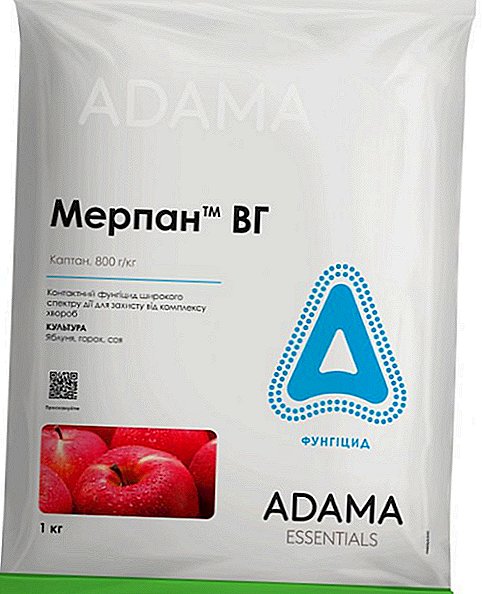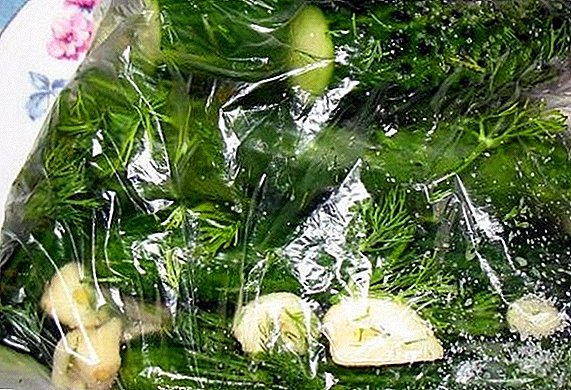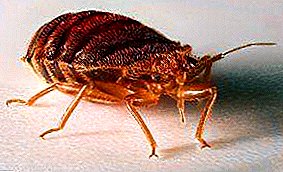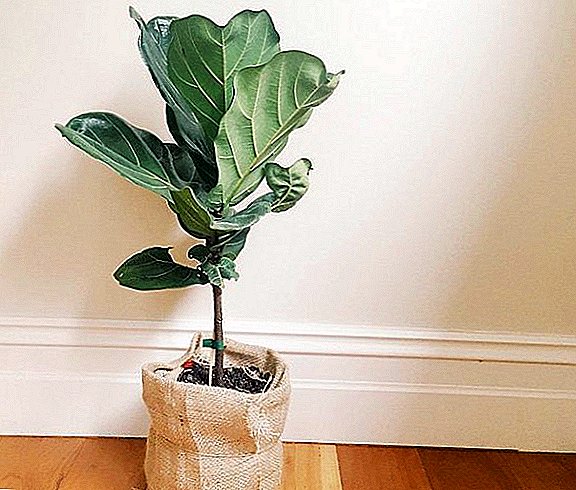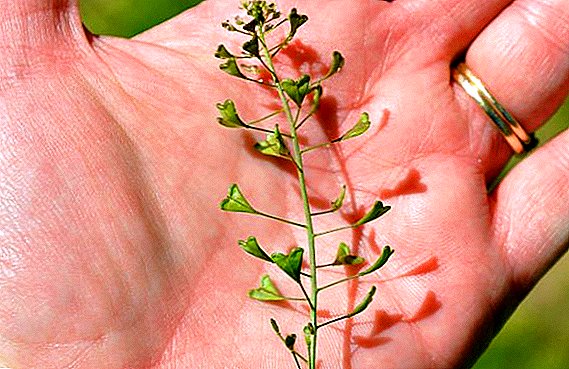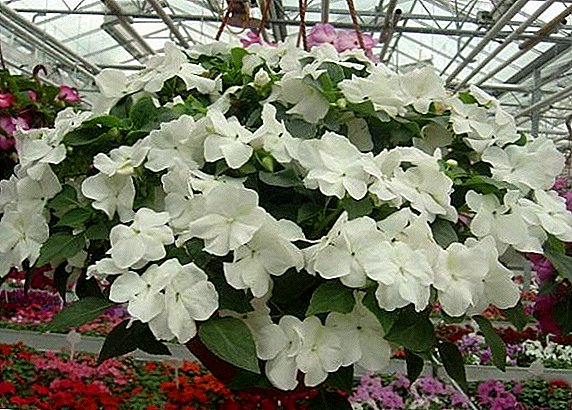 Decorative flowers with lush, large and bright inflorescences love to decorate their window sills, courtyards and suburban areas, many. One of these colors is impatiens ampelnoe, or balsam.
Decorative flowers with lush, large and bright inflorescences love to decorate their window sills, courtyards and suburban areas, many. One of these colors is impatiens ampelnoe, or balsam.
How to grow this flower from seeds, as well as what kinds it can be, how it can be used in landscape design - this is the subject of this article.
Botanical description
Impatiens ampelnoe, it is also called balsam or touch, from the family Balsaminaceae (Balsaminaceae) - are grassy annuals or perennials (garden or indoor flowers), which number more than 500 species in its genus. Balsamines have fleshy, whole, shiny leaves with serrated edges, at the base of which are glands. The color of the leaves is green, red-green or bronze. Juicy and branched shoots of balsamines of different varieties have a height of 15 to 50 centimeters. 
We advise you to learn how to care for indoor balsamic and what features of growing balsam in the garden.
Flowers - zygomorphic, growing one by one or in the form of inflorescences. Each flower is in the leaf bosom, and can be colored in different colors depending on the variety: white, pink, orange, red, purple, with stripes or speckled. There are created hybrids with small, colorful, double flowers and multi-colored leaves. Each flower consists of five sepals, one of which is drawn into the spur, as well as a five-membered corolla, and individual or paired petals.
Five stamens have grown together with the anthers located on the staminate filaments, which create a lid, falling away during the ripening of the stigma. Due to this, the flower is pollinated by cross pollination. Five carpels have a short column, as well as from one to five stigmas. The fruit is in the form of a juicy box, suddenly opening due to twisting sashes, or in the form of a berry-shaped box (depending on the species). Flowering - from the beginning of June to the end of September.
Did you know? It is interesting how impatiens attracts some insects to their pollination, and others to distract from nectar: drops of sweet liquid are released on the petioles and sawed edges of the leaves, which, when evaporated, turn into sugar crystals. These crystals attract the ants and distract them from the pollen that the bees collect freely.

Distribution and habitat
The homeland and habitat of balsams are the African and Asian tropics and subtropics. They also grow in Central Asia, in a temperate and tropical climate of North America and Europe.
Types of impatiens ampelnoe
Impatiens is not a very numerous genus. On the basis of the main types, breeders bred several varieties of garden and room balsams. Now we will tell you about each species and hybrids based on them.
Impatiens Waller - plants of this species have branched, densely covered with diamond-shaped or oval leaves. During flowering, the bushes are entirely covered with flowers. Plant height reaches up to 60 centimeters. The leaves have a decorative, red-brown color. Based on the type of impatiens Waller, scientists have derived hybrid varieties impatiens mix with different colors of colors:
- futura - plant with colorful flowers and dangling stems;
- symphony - early hybrid. It has a compact bush, covered with pink-red flowers;
- novette - low (15 cm), compact bushes. Bloom for a long time;
- colorpower dark red - the flower has blood red flowers;
- levender flame - bush with dark green leaves, against which stands a lot of large pink-red buds.




There are also variety groups divided into the following series, each of which holds up to 20 varieties:
- Accent FT - bush height 15-25 cm, with large flowers of one or two different color;
- Fiestaft - plant 30 cm tall. Flowers - terry, are one-or two-color;
- TempoF1 - in height to 25 cm, flowers - pink or peach;
- BrunoFT - hybrid resulting from bioengineering. Flowers are up to 6 centimeters in diameter. Coloring - the most diverse;
- StardustF1 - a plant with an original color of flowers: silvery in the middle, and at the edges have a wide orange, red or pink border;
- Firefly - bush 25 cm tall, the color palette is wide.

Impatiens Hocker - founder of the next hybrid species Impatiens New Guinea. These are tall bushes with lanceolate dark green leaves with red veins and large flowers.
Learn how to care for a New Guinean balsam at home.
New Guinea hybrids are divided into the following series:
- Paradise - has flowers of different shades, leaves are variegated;
- Rainforest Exotic - flowers of different color, there are multicolored;
- Jangle Rain - buds are painted in delicate tones;
- Harmony - compact bush with leaves of different colors. The flowers are large, there are fourteen of their various shades;
- Java - balsam with green or bronze leaves, and blooming bright buds;
- Mini Jini - blooms year-round small flowers;
- Divaro - Bushes have average buds of six different flowers;
- Sun Patiens Spreading Clear White - low bushes with motley foliage and white buds.



 Impatiens Peters - a separate grade of high balsamines with a slight down on shoots and foliage. The leaves are arranged on elongated cuttings. The flowers are small, scarlet color.
Impatiens Peters - a separate grade of high balsamines with a slight down on shoots and foliage. The leaves are arranged on elongated cuttings. The flowers are small, scarlet color.  Impatiens iron cone - A hybrid variety of balsamines, having glands at the base of each leaf. This is a garden plant, annual. Lanceolate leaflets are collected in the corollas at the top of the stem. Flowers are found cherry, white or pink color. The petals of the flowers are bent outward, arranged in several pieces in the axils of the leaves.
Impatiens iron cone - A hybrid variety of balsamines, having glands at the base of each leaf. This is a garden plant, annual. Lanceolate leaflets are collected in the corollas at the top of the stem. Flowers are found cherry, white or pink color. The petals of the flowers are bent outward, arranged in several pieces in the axils of the leaves.  Impatiens balsamic - a variety of garden varieties. Annual, poorly tolerated frosts. Bushes are lush, up to 70 cm high. The axils of the upper leaves form large, double, bright red flowers.
Impatiens balsamic - a variety of garden varieties. Annual, poorly tolerated frosts. Bushes are lush, up to 70 cm high. The axils of the upper leaves form large, double, bright red flowers.  Impatiens Tamarind - low indoor bushes, have large leaves and large buds, among which there are also terry. This species has the following hybrids:
Impatiens Tamarind - low indoor bushes, have large leaves and large buds, among which there are also terry. This species has the following hybrids:- Impmpatiens white - flower with white buds;
- Impatiens Pearl Blue - variety with bright pink inflorescences;
- Double Duet, Stardust Lavender, Rosette, Fiesta - varieties with large terry flowers.



Important! Flower juice is considered moderately toxic, so keep the plant away from children and pets.
Use in landscape design
Impatiens of all kinds - this is one of the many beautiful flower beds that adorn any flower beds. It is appropriate to place them in protected from wind blowing and not very dark places of the infield. Here are some options for decorating a country garden with these spectacular flowers:
- The vertical flowerbed with the composition of balsamines of different shades looks very elegant and decorative. Such a screen, painted in a multicolored gamut, will create a cozy atmosphere and decorate a summer corner in your garden.
- Along the garden paths the ridges with these flowers will look good.
- Ornaments for pergolas will be pots or pendant fixed to the walls, as well as floor vases in which balsams of different shades can be alternated.
- Low flowers in the form of carpet fill the space between the trees and shrubs.
- Due to the long flowering of balsamines and the variety of colors, you can create a spectacular addition to the composition with perennial flowers, which have a shorter flowering period.
- Tall varieties will decorate new mixborders with unfilled spaces between still small and not very overgrown perennials and bushes.
- On the flowerbeds you can plant low-growing varieties of various shades and choose their color range so that you can create any pattern or color transition in the form of a gradient.

A good company for balsamine on a bed will be composed of fuchsia, verbena, a bell and ageratum, the combination of boxwood and garden balsam looks interesting.
Growing and caring for plants
Impatiens do not require special care. These are unpretentious plants, perfectly adapting to the conditions of the environment, blooming long and abundantly. And yet, like any other ornamental plant, they need some care. Consider some requirements for the care of balsams.
Conditions of detention
Impatiens normally perceive a small shading, but in sunny places the leaves of the plants become brighter, and a greater number of buds form on the bushes. They are not afraid of direct sunlight, and in a strong shade the plants are drawn and laid bare. They can be planted in hanging pots, deep and not very wide garden and balcony containers and vases, with a volume of 3 liters.
Soil and fertilizer
Planted touchy in any fertile soil. If these are flowerpots, then the bottom should preferably be lined with brick crumbs or expanded clay. When plants begin to grow and bloom actively, they need fertilizer. Twice every 30 days during watering, mineral fertilizers should be diluted in water, intended for flowering balcony and garden flowers.  The following fertilizers work well:
The following fertilizers work well:
- "Fertika-luxury".
- "Merry Flower Girl".
- "Uniflor-bud".
- "Agricola for flowering".
Watering and moisture
Balsamines need to be regularly and abundantly watered:
- The ground beneath them should always be wet, but it is important to ensure that the water in the flower beds does not stagnate, otherwise the plants face rotting of the roots.
- If it is a perennial indoor plants, in winter the watering is reduced, and the top layer of soil in the pots should be allowed to dry completely.
- Also, indoor plants need regular spraying, only you need to make sure that the spray does not fall on the buds.
Relation to temperature
Temperature requirements for roomwalkers:
- The ambient air should be no lower than + 15 ... +18 degrees, and the most acceptable temperature - 20 degrees above zero. If the mercury column drops to plus 13, the plants may die.
- In the spring for hardening vases with balsams are carried to the balcony, taking into account the ambient temperature. Draft for Balsamine are not allowed.
- Annual impatiens growing outdoors are not afraid of strong sun, although on particularly hot days the leaves become slightly planted, and the buds close. But as soon as the sun leans towards evening, it is enough to water them to the root - and the plants come to life again.

Did you know? The name "impatiens" means "impatient" and indicates that in some species of the flower, at the slightest touch of ripe fruits, they crack, and the seeds fly away a long distance.
Reproduction and planting
Impatiens are propagated by seeds, as well as cuttings from the top of the stem. Next, we describe the features of each method.
Seeds  Balsam seeds can be purchased in specialized stores, where there is a huge selection. It is important when buying to pay attention to the timing of their collection, and not the timing of implementation, because the old seeds may simply not ascend.
Balsam seeds can be purchased in specialized stores, where there is a huge selection. It is important when buying to pay attention to the timing of their collection, and not the timing of implementation, because the old seeds may simply not ascend.
Important! At seeds of balsamine germination persists up to 7-8 years, but it is better to plant more fresh.
In order for your impatiens to bloom by early summer, they should be sown in the ground by mid-February:
- To prepare the seeds for sowing, they must first be disinfected for 10 minutes in a light solution of potassium permanganate, and then soaked for 24 hours in clear warm water.
- For future seedlings, you can take 0.5-liter plastic cups and puncture small holes in their bottom for drainage. Fill the bottom of the cups 1-2 cm with fine gravel or expanded clay.
- Fill containers for seedlings with nutrient and light soil. It can be purchased in a universal shop, but you can also prepare it yourself with the following composition: one part of garden soil, two parts of peat mass, one part of vermiculite and one part of coarse sand.
- Then the earth mixture needs to be spilled from above with a solution of "Fitosporin" in order to improve the composition of its microflora and kill the possible presence of a disease-causing spore.
- Sowing material is very sensitive to light, so the seeds need to be sown on the surface of moist soil and slightly push them into the ground, but not immersing them in depth.
- Planted seedlings are moistened with a spray bottle, covered with foil and placed on well-lit, warm window-sills.
- The temperature of the room where the seeds will germinate should be maintained at + 22 ... +25 degrees.
- At observance of a temperature mode and moderate humidity, by about 20 days the first sprouts should appear. As soon as single shoots appear, the film will need to be opened a couple of times a day in order to air the shoots and shake off the accumulated condensate from the film. Excess moisture is undesirable, otherwise sprouts can infect the fungus.
- When all the seedlings have risen (after 5-6 days), the bag should be removed completely, and the soil should be moistened.
- In the morning, in the evening and on cloudy days, it is advisable to add the amount of light to the seedlings using a fluorescent lamp to prevent their development.
- It is better to water future seedlings through the pan so that the root necks do not rot.
- To transfer seedlings from cups to open ground, garden containers or flowerpots are needed after the formation of a small bush, and also when the roots are woven over the whole earthen ball in a glass.
- Seedlings need to be planted in open ground, when there will be no threat of frost: from mid-May to mid-June, depending on the region of growth.
- Planting is necessary at a distance of at least 25 centimeters from each other.





VIDEO: SEED FOR SEEDS
Vegetative
For the vegetative propagation method, the following actions will be required:
- Choose from a parent plant a healthy shoot 8-10 centimeters long and cut with a sharp knife.
- Place the cutting in a container with water and put it on the illuminated window sill. Within a few days, the first roots will appear on the cuttings.
- After cuttings take root, they dive into small pots (10 centimeters in diameter).
- If rooting occurs in the spring, then a flowering plant will grow from the cutting in the same summer, which will delight the owners with a lush color all autumn and winter.
- Autumn rooting requires additional heat and light.

Features of care, depending on the place of detention
It is necessary to care for the impatiens depending on whether it is a houseplant or a garden. Let's see what care is needed in each of these cases.
Important! Once in 5 years, room balsams need rejuvenation, otherwise the flower may lose its decorative appearance.
Care recommendations indoor flowers:
- Balsamines are well adapted to high temperatures, so for the whole summer, flowerpots with them can be taken out into the open air and shaded from the sun's rays under canopies or under treetops.
- Temperature regimes should not change dramatically, therefore, with the beginning of the autumn days, the flowerpots should be brought into the house, not waiting for cold snaps.
- In winter, in indoor conditions, plants feel good at temperatures not lower than +12 degrees.
- The impatiens do not have periods of rest, therefore, with a short light day, from October to the end of March, it needs an additional light source in the form of fluorescent lamps for flowering.
- It is very important to feed the bushes with complex fertilizer once every two weeks.
- Watering should be carried out with warm settled water.
- In summer, watering should be more abundant, and in winter - as the earthen clod dries in the pot.
- When dry flat air bushes need periodic spraying.
- Every year should be pruned bushes to stimulate the growth of new shoots.
- When bushes grow, they need to be turned over into large pots or divided. This is best done in the middle of spring.

Look after garden balsam it is also easy, it can be done even by an amateur florist. Here are the works that need to be done for balsams growing in open ground:
- Regular evening watering, especially on hot days.
- To keep moisture in the soil longer, it is necessary to mulch the soil.
- Periodically weed and tear off withered inflorescences.
- Potash and phosphorus dressings are necessary 2 times a month, as well as watering with a solution of ash (pour 300 liters of ash with 2 liters of boiling water and leave to cool. Then the solution is diluted in 10 liters of water). Impatiens are also very fond of when they are sprayed with liquid fertilizers for leaves (foliar feeding).
- For the formation of a beautiful bush, you must regularly pinch the tops of the young branches.

Did you know? In Asian countries, one type of balsamine is a raw material for the production of henna.
Possible difficulties in growing
With all the simplicity and simple care for balsams in their cultivation can be faced with certain difficulties. Here is a list of some problems, their causes and solutions:
- Small and pale leaves on the bush, elongated and thinned stems. Reason: the plant lacks nutrients because of the exhausted soil in the pot, or perhaps the pot with a bush is in a very dark place. Solution: make the transfer of the bush in a larger pot or remove the upper part of the soil from the pot and fill it with fresh and enriched. If the problem arose due to lack of lighting, then you need to rearrange the pot in a more lighted place, but not under direct sunlight.
- Too elongated and bare shoots in plants. The reason: most types of touchy tend to stretch. Solution: regular pruning will help correct the flaws. This will give growth stimulation to the side shoots and contribute to flower rejuvenation.
- Few flowers on the bushes or none at all. The reason: the lack of nutrients or, conversely, an excess of nitrogen fertilizers that contribute to the growth of shoots and leaves to the detriment of flowering. Solution: competently carry out feeding.
- Twisted, dry and falling leaves. Reason: the air in the room is too hot. Perhaps a flower pot is standing near the heater or under the scorching sun on the windowsill. Solution: move the pot to a cooler place and spray regularly.
- The flower began to actively bloom, but then the flowers abruptly dropped. Reason: a sharp decrease in the ambient temperature; flower transplant made during flowering; transfer of earthen coma with a flower in too large flowerpot; dry soil in a pot for a long time. Solution: ensure optimum temperature; do not replant plants during flowering; need to roll flowers in the flowerpots, a little larger than the previous ones; Do not forget to regularly water and spray the flower.
- The variegated bush has lost its coloring. Reason: the flower is not enough light. Solution: these varieties more than others need sunlight, so they need to ensure it to the fullest.

Ampelnye flowers look great in hanging pots. Among the most suitable plants for hanging pots are geranium, verbena, bacopa, petunia, surfini, campanula, lobelia, and begonia.
Pests, diseases and prevention
We will tell about the main diseases and pests of impatiens, methods of dealing with them and preventive measures:
- balsam mosaic - young leaves are affected, which are covered with yellow spots, and then deformed. The spots are able to grow, the yellowness completely covers the leaves, and then falls on the stem, which leads to unilateral necrosis. The bush stops growing and dies.
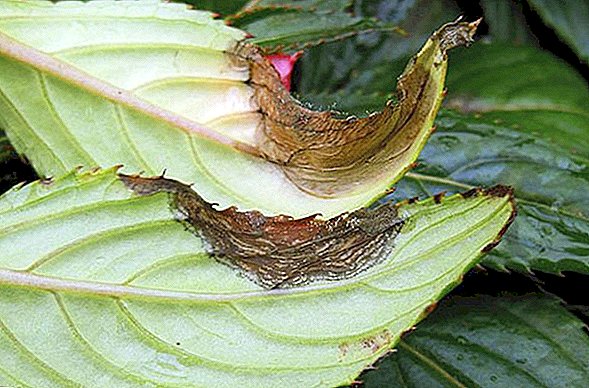 The cause of the disease is a virus spread by thrips or ticks. Elimination: it is already useless to treat flowers; therefore, prevention is important, which consists of improved care and insecticide spraying. Affected plants must be destroyed;
The cause of the disease is a virus spread by thrips or ticks. Elimination: it is already useless to treat flowers; therefore, prevention is important, which consists of improved care and insecticide spraying. Affected plants must be destroyed; - gray rot - a fungus that infects leaflets and shoots with brown spots, which are subsequently covered with a gray bloom of fungal spores. As a result, the plant dies. The cause of the fungus can be contaminated water or soil. The disease can develop due to watering with too cold water or drafts, or if the plant is weakened due to hypothermia. Disease prevention: carry out proper preventive care by pouring warm clean water, airing the room, creating an acceptable temperature, maintaining clean indoor air. Also, at the first symptoms (appearance of the first spots on the leaves), it is advisable to immediately cut off the affected leaves, transplant the shrub to another soil and spray it with "Fundazole";
- bacteriosis - the appearance of watery spots on the leaves and shoots, which subsequently become brown and cover all the leaves. After that, the plant dies. The reason is contaminated soil with a surplus of moisture and fertilizer, as well as high temperatures. Elimination: at the first appearance of the spots, they should be immediately removed and spray the healthy part of the plant with copper-containing preparations or Bordeaux mixture. If the disease has spread too quickly, it is better to isolate the flower or destroy it;
- powdery mildew - on sheets of white bloom occurs, which then affects the whole bush. The reason - poor circulation of fresh air in the room, a broken schedule of fertilizing and watering, insufficient lighting and temperature changes. Solution: remove diseased leaves and apply a soda solution of soda (2 g soda per 1 l of water) for spraying. Well helps and fungicide "Byleton." It is also necessary to adjust the care of the plant;
- spider mite entangles with cobwebs the bottom of the sheet. The reason is too dry air. Solution: spray the plant with soapy water, or wipe the leaves with alcohol, or use special equipment like "Aktellika", "Fitoverma". Do not forget to maintain the desired moisture for the flower.


Cultivation Reviews





 The cause of the disease is a virus spread by thrips or ticks. Elimination: it is already useless to treat flowers; therefore, prevention is important, which consists of improved care and insecticide spraying. Affected plants must be destroyed;
The cause of the disease is a virus spread by thrips or ticks. Elimination: it is already useless to treat flowers; therefore, prevention is important, which consists of improved care and insecticide spraying. Affected plants must be destroyed;
